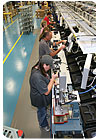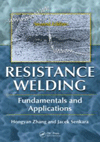
The manufacturing floor encompasses 65,000 square feet and includes about 220 assemblers. Photo courtesy Philips Respironics.
Philips Respironics isn’t resting on its laurels in the healthcare market, as evidenced by the opening in April 2009 of a $32 million plant in Murrysville, PA, devoted to high-volume, low-mix production of special devices used to treat obstructive sleep apnea. Known as CPAP (continuous positive airway pressure) and BiPAP (bi-level positive airway pressure), these devices deliver a continuous flow of air to keep the airway open so users get quality sleep throughout the night. Philips has made CPAP devices since 1985 and BiPAP devices since 1989.
The company’s latest CPAP and BiPAP devices are assembled, tested and packaged in this new two-story, 172,000-square-foot facility, according to Eric Kulikowski, director of North American operations. The plant’s manufacturing floor encompasses 65,000 square feet, and there is 35,000 feet of warehouse space. As of January, the plant employed around 250 people, including about 220 assemblers.
When asked why the facility was built, Kulikowski says, “We weren’t able to optimize the existing factory [also located in Murrysville] because we were trying to be everything to everybody and had run out of space for production. We needed to have a focused factory-what we call a ‘center of excellence’-for it to be world class. To build a factory in the U.S. is not usual these days, so it had to be something special, rather than going to a low-cost country or outsourcing the business.”
Kulikowski says the new plant is world class because it incorporates the latest in lean manufacturing automation and software technology for the most efficient and effective operation. In addition, the facility is green and in the final stages of review for Leadership in Energy and Environmental Design (LEED) certification. Finally, he says it’s a plant people want to work in-one that’s bright, clean and quiet, with open space and several worker amenities.
Product assembly is fairly straightforward. “No major capital pieces of equipment are involved in assembling our products,” says Kulikowski. “It’s basically hand assembly and using torque drivers, things like that. However, all the supporting processes are fully automated. In fact, this plant is much more heavily automated than others Philips operates.”
He cites three main examples. One is the company’s first robot, which is going into service in May to aid in device testing by turning knobs and pushing buttons. Another is a collator that assembles literature kits for customers in place of laborers doing it by hand. Third is equipment that carries completed product to the warehouse.
Another innovation first for Philips is operating a plant that is completely paperless. All work instructions and shop travelers (documents created from sales orders) are stored electronically.
No high-level subassembly is done at the new plant, as it is outsourced. Kulikowski says 80 percent to 90 percent of parts come from North America. The rest comes from U.S.-based suppliers that have operations in the Asian Pacific region, Mexico and Europe.
As for the plant’s production capacity, it was increased from April 2009 to January 2010 to reach target volume, notes Kulikowski. He wouldn’t give specific numbers, but did say thousands of units are assembled daily.
“Also helpful, in terms of efficiency, is the fact that the products are designed to go together nicely without glues or anything like that,” Kulikowski says. “This made it easier for us to transition employees from the existing factory to the new factory because the assembly process itself is something they were familiar with.”
Editor’s note: If you know a facility that’s opening, growing or investing in new equipment, we’d like to hear about it. Send an e-mail to John Sprovieri, editor of ASSEMBLY, at sprovierij@bnpmedia.com, or call 630-694-4012.



